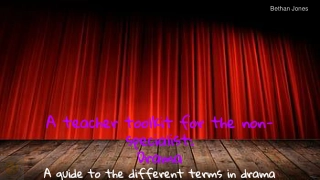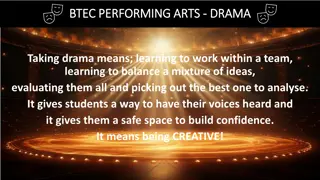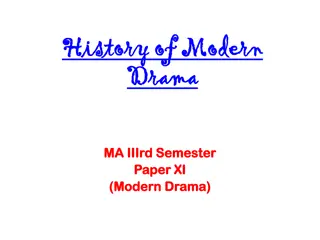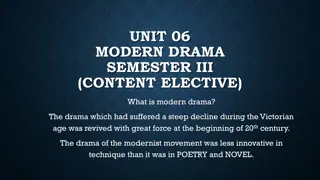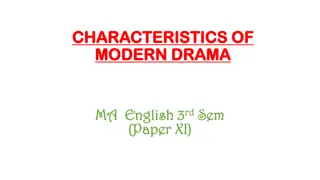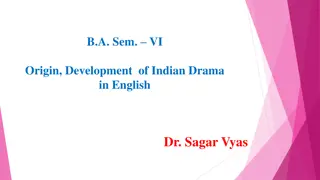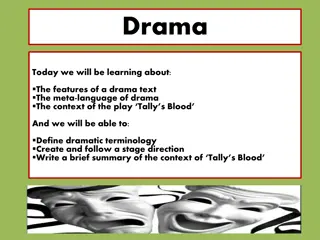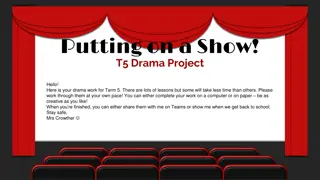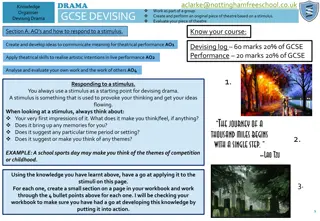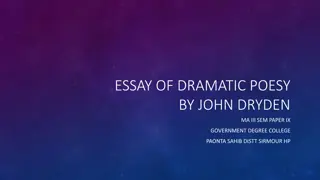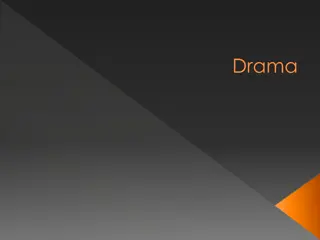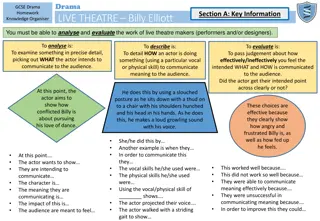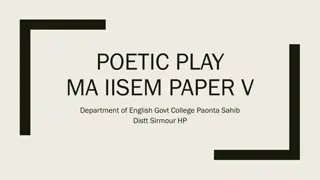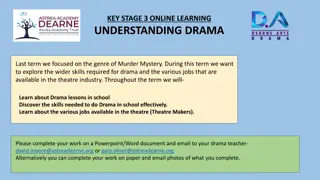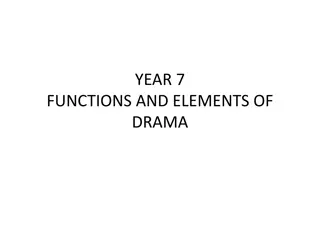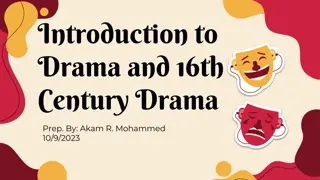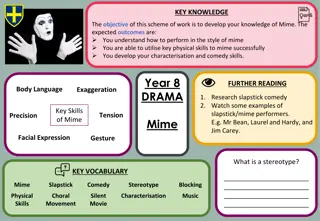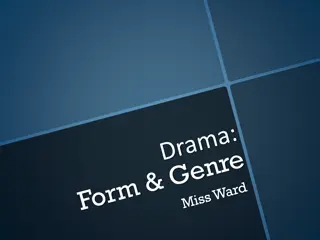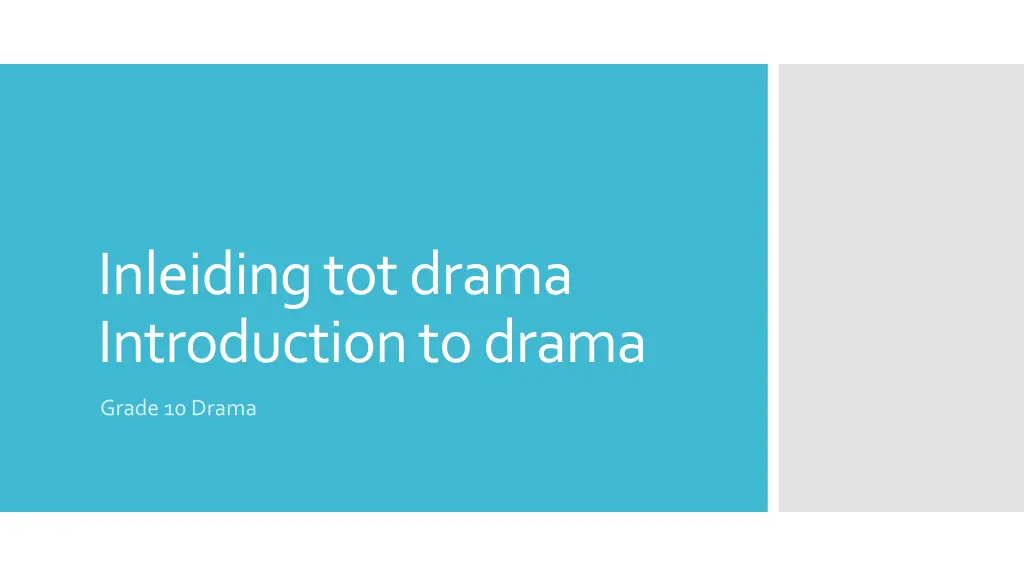
Understanding Drama: From Greek Origins to Modern Applications
Drama, deriving from the Greek word "draein," is a fundamental aspect of human experience explored through action, interaction, and empathy. Whether in childhood play or adult therapy, drama serves as a powerful tool for learning, communication, and understanding. Discover the roots of drama and its varied applications in psychology, sales training, marriage counseling, and live theater.
Download Presentation

Please find below an Image/Link to download the presentation.
The content on the website is provided AS IS for your information and personal use only. It may not be sold, licensed, or shared on other websites without obtaining consent from the author. If you encounter any issues during the download, it is possible that the publisher has removed the file from their server.
You are allowed to download the files provided on this website for personal or commercial use, subject to the condition that they are used lawfully. All files are the property of their respective owners.
The content on the website is provided AS IS for your information and personal use only. It may not be sold, licensed, or shared on other websites without obtaining consent from the author.
E N D
Presentation Transcript
Inleidingtot drama Introduction to drama Grade 10 Drama
Drama komvan die Grieksewoorddraein wat beteken om te doen. Onsgebruik aksieeninteraksie om allerhandemenslikeervarings te verken. Drama is eintlikdeel van onslewe vandatonskleinis, omdat kinders altyd speel! Terwylkinders speel dink hullehulleis ander mense! Wat is drama? Dink bietjie aanjougunstelingkinderspeletjies soosMevrou- mevrou endokter-dokter. Eenvan die belangriksteinstrumente in drama is empatie of die vermo om saammet iemand anders te voelof om in iemand andersse skoenete staan.
Drama comes from the Greek word "draein" which means to do. We use action and interaction to explore all kinds of human experiences. Drama has been a part of our lives since we were little, because kids are always playing! While kids are playing, they think they are other people! Think a little about your favorite children's games like Madam Madam and Doctor - Doctor. One of the most important instruments in drama is empathy either the ability to feel with someone else or to stand in someone else's shoes. What is drama?
Drama kangebruik word om mensedinge deur ROLSPEL te leer. Baiemaatskappyegebruik drama-instrumente om hulle verkoopspersoneelop te lei. Verskillende soortedramas enwaarvoor drama gebruik word: In sielkunde of terapieword drama ookbaiegereeld gebruik. In huweliksberading word drama ookgebruik byvoorbeeld wanneermense n argument gehadhet kanhulledie rolvan die anderpersoonpersoonspeel om te probeer verstaanhoe die anderpersoonvoel. Teater is die term wat gebruik word vir n optrede voor n LEWENDIGE gehoor. Ditis n ontmoetingin lewende lywewaardie aanwesigheidvan die gehoor n impakop die akteurs het.
Drama can be used to teach people things through ROLE PLAY. Many companies use drama instruments to train their sales staff. Different types of drama and what they are used for: In psychology or therapy, drama is also used very frequently. In marriage counselling, drama is also used, for example when people have had an argument they can play the role of the other person to try to understand how the other person feels. Theatre is the term used for a performance in front of a LIVE audience. It is where the presence of the audience has an impact on the actors
n Geskrewe drama het n baie spesifiekeformaat. Die rede daarvooris: Die gehoormoet nadie toneelstukkankyk, maar mensemoet ookdie toneelstuk kanlees. Die toneelteks: Die skriftelikeweergawevan n toneelstukbestaanuit verhoogaanwysings(Ditis die goed in hakies.) Verhoogaanwysings s virdie akteur wat hymoet doen!
A written drama has a very specific format. The reason for this is: The audience must be able to watch the play, but people must also be able to read the play. The Play text: The written version of a play consists of stage directions (This is the stuff in brackets.) Stage directions tell the actor what to do!
Ensemble: n Groep akteurs wat saamwerk. Menseagterdie skerms: Die mense wat agterdie skerms werk om die produksie glad te laatverloop. Ontwerper: Die persoon/ mense wat vir die visuele / enof klankelementevan die drama-opvoeringverantwoordelikis. Woordeskat: Regisseur: Die persoonwat daarvoorverantwoordelikis om die opvoeringaanmekaarte sit, al die elemente van n produksie te ko rdineerom n geheelvoorte stel. Toneelteks: ookdie draaiboekgenoem, die skriftelikerekord van n dra wat gebruik word as die basis waaruitdie opvoeringgeskep word.
Ensemble: A group of actors working together. People behind the scenes: The people who work behind the scenes to make the production run smoothly. Designer: The person / persons responsible for the visual and / or sound elements of the drama performance. Vocabulary: Director: The person responsible for putting the performance together, coordinating all the elements of a production to represent a whole. Play text: also called the screenplay, the written record of a play that is used as the basis from which the performance is created
Videos: Introduction to theatre: https://youtu.be/sNWrOuwzax8
Skryf neer in jouboek wat jy graaghierdiejaaruit drama willeer. Huiswerk: Write down what you would like to learn from drama this year!

